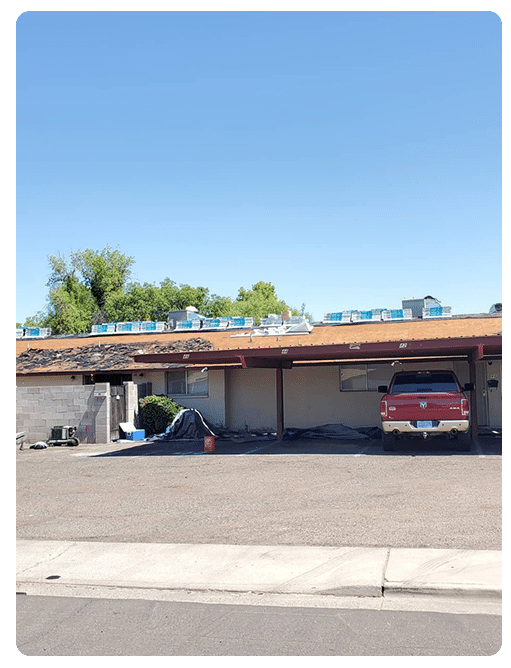Trees can be a lovely addition to any home, providing shade and beauty. However, when planted too close to the house, they can cause extensive damage to roofs due to their roots and branches.
This article will discuss tips for keeping trees away from your home’s roof in order to prevent such damages.
The first step is determining which type of tree you want near your home. Some trees are more prone to causing damage than others, so it is important to consult with an arborist or other knowledgeable individual before making any decisions.
Additionally, proper planting techniques should be employed when selecting the location for the tree; this includes ensuring that there is enough space between where the tree will be placed and your roof line.
Finally, regularly pruning and trimming nearby trees can help reduce potential risks associated with having them close by.
Selecting The Right Tree
When selecting a tree to plant near your home’s roof, there are several factors to consider.
First and foremost is the height of the mature tree when fully grown.
Trees located too close to the house can not only cause structural damage from their roots but can also block out sunlight or interfere with satellite signals if planted too close.
It is therefore important to select trees that will remain relatively small in size even as they reach maturity.
The type of soil in which you plan on planting the tree should be taken into consideration as well, as it may affect its full-grown height and spread.

Additionally, certain species are more prone to disease than others so research should be conducted before purchasing any tree for near your home’s roof.
Understanding Tree Growth
Selecting the right tree for your home is only half of the equation.
Understanding how trees grow, and how to keep them away from your roof can be just as important when it comes to protecting both you and your property.
Trees are living organisms that naturally grow in size over time.
The branches of a tree expand outward from its trunk, and if left unchecked, could eventually reach too close to your roof or other parts of the house where they’d cause damage.
To prevent this kind of issue, it’s best to prune any new growth on a regular basis and have any hazardous limbs removed before they become an issue with their proximity to the roofline.
Additionally, selecting smaller species that don’t get very large can help ensure that they stay away from more vulnerable areas of your home while still offering all the benefits associated with larger trees such as shade and beauty.
Planting Techniques
Planting techniques are an important part of keeping trees away from a home’s roof. When choosing trees to plant near the house, it is important to consider the size and shape of mature specimens as well as their growth rate.
Spreading tree species such as maples should be avoided because they will quickly grow close enough to reach the eaves. Trees with dense canopies that do not get too large or wide are ideal for providing shade without getting too close to the structure.
In addition, planting trees at least 10 feet away from your home’s foundation helps protect against damage caused by roots growing into pipes and walls. To ensure long-term success, pick native species adapted to local climates and soil conditions.
Before deciding on which variety of tree you want to plant, research how tall it grows and how much space its root system needs in order for it to thrive. This information will help you find varieties that won’t outgrow their planned locations within a few years.
Creating A Buffer Zone
Creating a buffer zone between your home’s roof and trees is an effective way to keep the two separate.
This can be done by removing any branches that are hanging over or close to the roof, as well as planting any new trees far enough away from the house that their roots won’t cause damage when they grow larger.
Additionally, adding mulch around tree bases can help protect against root growth underneath your home’s foundation.
Proper maintenance of this buffer zone will be necessary in order to ensure it remains effective.
Regularly monitoring for signs of encroaching roots or branches should become part of your regular household routine.
Any potential issues should be addressed right away with pruning, trimming, and other appropriate methods.
Taking action quickly is essential for protecting the safety of your home’s roofs and foundations while keeping its aesthetic appeal intact.
Identifying Potential Hazards
Tree branches can pose a significant threat to the roof of your home. Before attempting to remove any trees, it is important to identify potential hazards and take appropriate precautions.
It is essential to inspect for dead or dying limbs that may be susceptible to breakage in strong winds or heavy snowfall, as well as any signs of disease or damage from pests. Additionally, tree growth should be monitored – particularly near power lines – in order to prevent accidental contact with utility wires which could lead to damaging sparks or fires.
It is also possible that roots growing under the foundation of your house may cause damage over time by exerting pressure on walls, floors, driveways and walkways; therefore, detecting and removing them before they become an issue is necessary.
To minimize further risk, consider cutting back overhanging branches at least four feet away from the roof’s edge and clearing away dry leaves accumulated around gutters and valleys where water flow might be blocked during storms. With these precautionary steps taken into account, you can protect not only your home but surrounding plants as well.
Regular Pruning And Trimming
Regular pruning and trimming of trees is essential in order to keep them away from your home’s roof. This helps reduce the risk of branches scratching or damaging shingles.
Pruning should be done at least once a year, preferably during late winter or early spring when trees are dormant and before new growth begins. It is important to remove any dead or broken limbs that may cause damage if left unpruned. Additionally, removing low-hanging branches will help clear pathways and make it easier for people passing by to see what’s ahead without being obstructed by tree limbs.
Furthermore, this can also lessen the chances of small animals nesting on your property as they won’t have easy access to elevated areas near the house. Regular pruning and trimming can also improve air circulation around your home, reducing humidity levels which can lead to mold and mildew growth.
Finally, ensuring there is adequate space between the tree canopy and roofline will ensure better visibility for you and your neighbors while providing an aesthetically pleasing view of your home’s exterior.

Utilizing Professional Services
The installation of physical barriers often proves to be an effective solution for keeping trees away from home roofs. These can include, among other things, constructing a fence along the perimeter of a house or installing netting around vulnerable areas of the roofline.
Planting wind-tolerant species such as evergreens may also help reduce damage caused by branches swaying in strong winds, while removing dead limbs and trimming existing tree canopies will limit them from growing too close to the roof structure.
Additionally, professional arborists are available who specialize in pruning and preserving trees; they are able to interpret signs that indicate potential problems with a particular tree before it becomes an issue for the homeowner. Utilizing their services on a regular basis ensures that any issues that arise can be addressed quickly and effectively, protecting both the home’s roof and its surrounding landscape.
Conclusion
Tree care is essential for preventing damage to a home’s roof.
Careful selection of the right tree, understanding its growth, utilizing proper planting techniques and creating a buffer zone are all necessary steps when considering trees near your home.
Additionally, identifying potential hazards, such as broken branches or diseased trunks, and regular pruning and trimming should be part of routine maintenance.
Professional services may also be needed at times depending on the size or condition of existing trees.
Taking these precautions will help ensure that trees remain healthy while keeping them away from your home’s roof.


